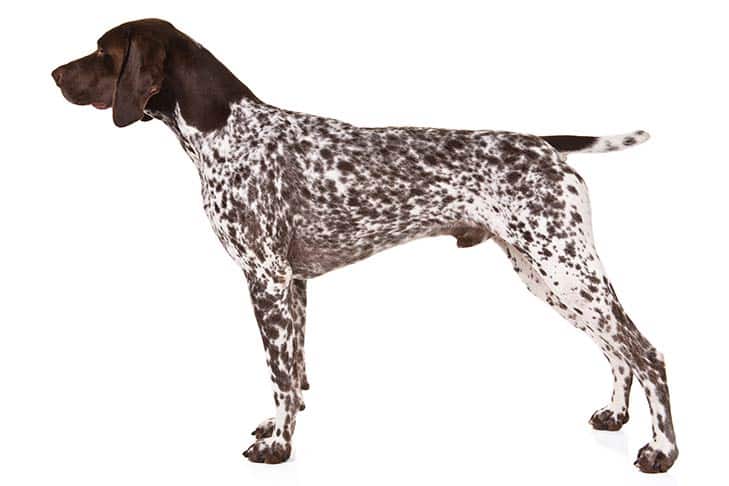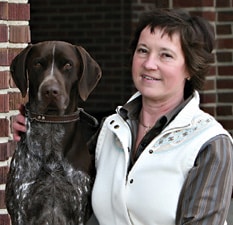Interview with from Sporting Group Judge Charlene Rutar.
1. Where do you live? How many years in dogs? How many years as a judge?
2. What is your original breed? What is/was your kennel name?
3. Can you list a few of the notable dogs you’ve bred? Any performance or field titles?
4. How important are Performance and Companion titles in a Sporting Dog?
5. Have you judged any Sporting Breed Specialties?
6. Do you find that size, proportion, and substance are correct in most Sporting breeds?
7. Is breed-specific expression important to you as a judge? Can you offer some examples?
8. What are your thoughts on the current grooming practices among the coated breeds?
9. Are the Sporting breeds in good shape overall? Any concerns?
10. In your opinion, how do today’s exhibits compare with the Sporting Dogs of the past?
11. Why do you think the Sporting breeds make up a large portion of the typical show’s entries?
12. Just for laughs, do you have a funny story you can share about judging the Sporting Group?
Sporting Group Judge Charlene Rutar
I have owned German Shorthaired Pointers for 38 years and have bred them for 35 years under the “White River” prefix. I have exhibited my dogs in the show ring since 1985, and have handled them in AKC Hunt Tests since 1986. White River boasts a Hall of Fame dog and three on the ROM and ROMX rolls, 53 bench champions, 34 hunt titles, as well as multiple titles in obedience, agility, tracking, rally, and scent work.
I have given back to my chosen hobby and sport by serving the GSP Clubs of Indiana and Middle Tennessee as an officer and committee chair, working for the GSPCA as Breeder Education Coordinator, NSS Executive Committee Chair, NSS Trophy Chair, and on the Shorthair Journal magazine. I am an active member of the Anderson (Indiana) Kennel Club, serving as President, Vice President, and Judges’ Transportation Chair for several years. I have loved volunteering for the past six years with the Hamilton County Indiana 4-H Dog Project.
I was first licensed to judge Shorthairs in 2011. Presently, I judge all Sporting breeds, four Non-Sporting breeds, and one Toy breed. In addition to the ten GSP Specialties I have judged to date, eleven other Sporting breed clubs have entrusted me with their Specialties—two at the national level.
I have a BS in Management from Purdue University and an MBA from Xavier. My professional life began as a federal auditor, progressively specializing in healthcare programs. I have worked in healthcare administration for 37 years.
Where do I live? How many years in dogs? How many years as a judge? I live in central Indiana on a 60-acre farm that we bought as much for the dogs as for ourselves. I have been breeding and exhibiting for 35 years, and now judging for 10. My family always had purebred dogs. As kids, we enjoyed them performing the functions for which they were bred. The Pug got draped in patriotic flags and was shown off in the small town Fourth of July parades. The Dalmatian accompanied my brother as he trained for cross country meets. I have always been fascinated with the magic of inbred instincts and with the abilities honed by necessity in the breeds “way back when,” perfected and preserved by breeders through the years. I really got “into dogs” when my sportsman husband introduced me to—and we began living with—Sporting Dogs. I was so delighted to know that there is a whole group of dog breeds with inbred function that involves embracing the great outdoors!
What is my original breed? What is/was my kennel name? My original and current breed is the German Shorthaired Pointer. I breed under the kennel name “White River,” chosen because of the hours spent running my dogs along the banks of said river. I am proud to say that I have mentored two of my puppy buyers to the point that they have joined me in this breeding program and now share the kennel name.
Can I list a few of the notable dogs I’ve bred? Any performance or field titles? White River German Shorthairs are well-known within the breed fancy (less so in the all-breed world, I think), primarily for our stud dogs. The two most notable being multi-specialty winners and all-time top producers; Am./Can. CH White River’s Ziggy Stardust JH, and his grandson, GCHG TRF White River Howlin’ At The Stars JH BN CD RA DS. To put it into perspective, when you lined up the top 17 winners, BOB through AOMs, WD and WB at our 2021 National Specialty, all but two had these two dogs in their pedigree. And yes, we have 33 Hunt Test titles, 14 Obedience and Rally titles, and a few GSP Club of America Retrieving Dog titles on our roster. I chose a totally versatile breed, so, of course, our extended family is enjoying the explosion of Performance venues in recent years. White River now claims dogs titled in Coursing, Tracking, Fast CAT, Barn Hunt, Dock Diving, Farm Dog, Trick Dog, Agility, Scent Work, and probably a few more that I can’t recall or don’t know about. White River is proud to have produced the first GSP to achieve the Scent Work Master Elite title.
How important are Performance and Companion titles in a Sporting Dog? I think Performance and Companion activities are vital these days to Sporting Dogs. By definition, these breeds evolved and are bred to work happily and tirelessly with people, accomplishing given tasks. In current times, actual hunting fits less and less into most lifestyles; no problem if there are other fun and active tasks to channel the Sporting Dog’s energy and desire to please. A bonus is that so many of these tasks play to the special instincts and abilities that Sporting Dogs have. These venues give gun dogs, retrievers, tollers, and truffle dogs opportunities to love and be loved, without blood-letting.
Have I judged any Sporting Breed Specialties? Of course, I have judged many GSP specialties, working at the national, regional, and local levels. I have also enjoyed the honor of judging Brittany, Gordon Setter, Irish Setter, English Springer Spaniel, Cocker Spaniel, Weimaraner, Vizsla, and Spinone Specialties as well as National Sweeps for German Wirehaired Pointers and Welsh Springer Spaniels.
Do I find that size, proportion, and substance are correct in most Sporting breeds? The answer here varies a lot depending on the breed. I feel that most breeders are quite serious about conforming to the size requirements of their standards, though current fads can affect proportion. A few of the Sporting breed standards are not terribly clear as to what desired proportion is. I’ve seen wide variation in substance within many breeds. Interpretation of a written standard is a subjective thing, and there is room for different preferences. I would ask breeders to strive to keep focus on the work the breed was developed to do, and acknowledge that soundness and sturdiness should be inherent in their breed type.
Is breed-specific expression important to me as a judge? Can I offer some examples? Expression is created by how the head is built. Whether or not a given breed is considered a “head breed,” one should be able to tell the breed by looking at just the head peeking over the fence. The Setter’s parallel planes, chiseling under the eye, balance of muzzle and backskull give him a regal expression. The Spaniels are prized for their soft, melting expressions created by a rounder, more forward-looking eye, and by their low-set ears. Expression is a hallmark of so many; the clownish Irish Water Spaniel with his topknot and beard, the intensely human look created by the unique head structure of the Spinone, the heavy brow and furrow between the eyes which contribute to the “stodgy old gent” vibe of the Clumber.
What are my thoughts on the current grooming practices among the coated breeds? A glossy, healthy coat, trimmed to showcase correct underlying structure, is a work of art—both the breeder’s and groomer’s art. Art appreciation is the joyful part of the judge’s job. I’d prefer that the grooming not get in the way of my job of assessing the quality of the coat or the structure underneath. Product and frequent bathing prevent the judge from appreciating the protective jacketing on some Retrievers, and the cool, smooth texture needed on the Spaniels to help them stay protected in the field without becoming a burr and brush magnet. Sculpting, to hide or enhance, I find somewhat silly since I’m going to get my hands in where they need to be to find the framework underneath. I actually get annoyed at whisker removal, since they are part of the scenting toolkit and serve as antennae, protecting a working dog from pokes and scrapes.
Are the Sporting breeds in good shape overall? Any concerns? On balance, I think the dogs seen in the ring are attractive and healthy. Some Sporting breeds appear to me to be getting stronger in terms of living up to their breed standards. Thus, I believe those breeds have a dedicated community of breeders working hard to preserve and improve them. In other cases, I find myself wondering sometimes if breeders/exhibitors really grasp “type” and proper structure for their breed. Today’s breeding practices (not just for Sporting dogs) tend to result in fewer litters spaced out over more time, which makes it difficult to set traits with a tight line. It also might mean that people show what they have, even if it may not be their ideal dog. Follow this out to its natural conclusion and you have the top-ranked dogs of quite average quality becoming the breeding stock for future generations.
In my opinion, how do today’s exhibits compare with the Sporting Dogs of the past? This is a really tough question to answer, since “in the past” I was looking at any given breed through my rookie eyes. What I thought was beautiful—or what I failed to appreciate—30 years ago, I would now see through a hopefully much more discerning eye. Some breeds are gravitating to a different style today, which I would not label better or worse as long as they are meeting the standard. Thinking of some of the great dogs I have had my hands on more recently, I want to shout out, “Yes! There are great breeders with fantastic vision taking care of this breed.”
Why do I think the Sporting breeds make up a large portion of the typical show’s entries? By sheer numbers, the Sporting Group has the advantage of having three of the Top Ten AKC registered breeds; with the Labrador Retriever dominating the #1 spot for decades. Also, I think that folks who are drawn to Sporting breeds choose them because they want to get out and do something with them. Maybe they have a few more competitive bones in their bodies? And there are so many unique and beautiful breeds involved. Who wouldn’t want to show them off!?
Just for laughs, do I have a funny story I can share about judging the Sporting Group? The Sporting Group is my first Group, and none of us start out smooth as glass handling the task. I am sure that the exhibitors in the ring during the first few times I did the Group tittered a bit at some of my struggles. They could tell you the funny stories, not I.










